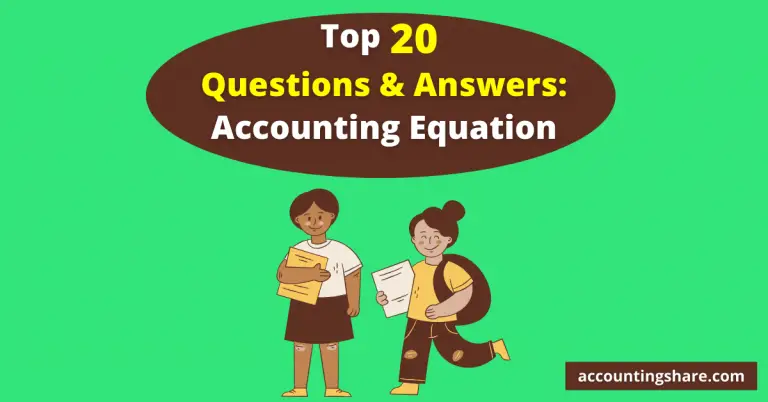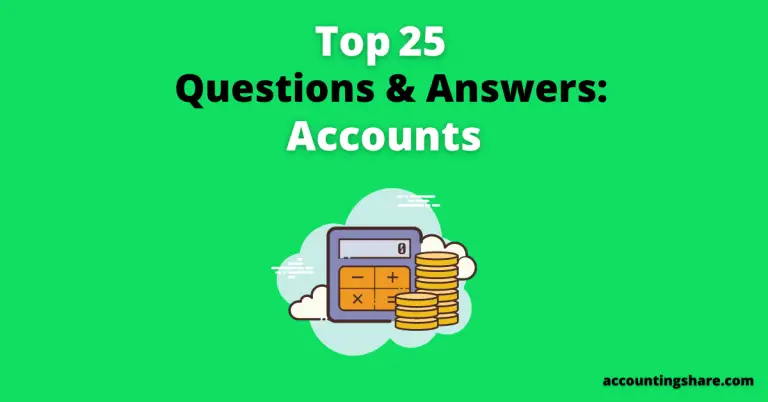Top 20 Questions and Answers-Cash Flow Statement [With PDF]
In this post, we’ll learn the Top 20 Questions and Answers-Cash Flow Statement. In accounting, the cash flow statement is obviously important.
This article will provide you with a quick overview of the cash flow statement.
So let’s get started.
Questions and Answers-Cash Flow Statement
Question-01: What is the cash flow statement?
Answer: The cash flow statement is a basic financial statement that shows the cash receipts, cash payments, and net change in cash from operating, investing, and financing activities over a given period.
Question-02: What is the purpose or objective of the cash flow Statement?
Answer: The information in a statement of cash flows can be used by investors, creditors, and others to evaluate the following.
- Capacity of the entity to produce future cash flows.
- The company’s ability to pay dividends and fulfill its obligations.
- The reasons for the discrepancy between net income from operating activities and net cash provided (used).
- Investing and financing cash over a period of time.
Question-03: What is the necessity or importance of a cash flow statement?
Answer: The necessity or importance of the cash flow statement is as follows:
- Evaluation of cash position of the enterprise.
- Forecast of future Cash Position.
- Preparation of long-term plans.
- Evaluation of ability to pay liabilities.
Question-04: What are the cash flow statement’s drawbacks or limitations?
Answer: The cash flow statement has the following limitations:
- Failure to show the non-cash changes of assets.
- A clear picture of cash position is not available.
- Not helpful for long-term financial analysis.
- A fund flow statement is more important than a cash flow statement.
Question-05: What are cash and cash equivalent?
Answer: Cash means cash in hand and cash equivalent means short-term and highly liquid investment.
Question-06: What’s the primary distinction between a cash book and a cash flow statement?
Answer: the primary distinction between a cash book and a cash flow statement is that a cash book is a book that shows cash receipts, cash payments, and cash in hand at any given time. On the other hand, a cash flow statement is a statement that shows the inflows and outflows of cash at a specific point in time.
Question-07: What is the main difference between a fund flow statement and a cash flow statement?
Answer: The main difference between a fund flow statement and a cash flow statement is that the main purpose of a statement of funds flow is to determine the amount of change or increase in working capital in an accounting year. On the other hand, the main purpose of a cash flow statement is to determine the amount of closing cash condition in a given financial year, as well as to present cash inflows and outflows.
Question-08: What are the different types of cash flows?
Answer: The cash flow statement divides cash receipts and payments into three categories which as follows:
- Operating Activities.
- Investing Activities, and
- Financing Activities.
Question-09: What are the operating activities?
Answer: Operating activities are the enterprise’s primary revenue-generating activities as well as any other activities that are not investing or financing.
Question-10: What are the investing activities?
Answer: Investing activities refer to the purchase and sale of long-term assets and other investments that are not cash equivalents.
Question-11: What are the financing activities?
Answer: Financing activities are those that cause the size and composition of the enterprise’s equity capital and borrowings to change.
Question-12: What are the sources of information for preparing a cash flow Statement?
Answer: There are three sources of information for preparing a cash flow statement, which is as follows:
- Comparative Balance Sheets
- Current Income Statement
- Additional Information.
Question-13: How many methods are there for preparing a cash flow Statement? And what are they?
Answer: There are two methods for preparing a cash flow statement which is as follows:
- Direct Method and
- Indirect Method
Question-14: What are the three main steps in preparing a cash flow statement?
Answer: The three main steps in preparing a cash flow statement are as follows:
- Convert net income from an accrual to a cash basis to determine net cash provided/used by operating activities.
- Evaluate changes in noncurrent asset and liability account balances and record them as investing and financing activities or noncash transactions.
- Verify that the net change in cash on the statement of cash flows agrees with the change in the Cash account reported on the balance sheet.
Question-15: What is the indirect method?
Answer: The indirect method is a method of calculating net cash provided by operating activities by adjusting net income for non-cash items.
Question-16: Why Companies favor the indirect method for preparing cash flow statements?
Answer: For two reasons, businesses prefer the indirect method:
- It’s easier to prepare and less expensive, and
- It highlights the differences between net income and operating cash flow.
Question-17: How to calculate net cash provided or used by operating activities under the indirect method?
Answer: The indirect method’s formula for calculating net cash provided or used by operating activities is as follows:
Net cash provided or used by operating activities = Net income +/- adjustments (Add back non-cash expenses, deduct gains and add losses)
Question-18: What is the direct method?
Answer: The direct method is a way of preparing a cash flow statement that shows operating cash receipts and payments, making it more consistent with the statement’s objective.
Question-19: What is free cash flow?
Answer: Free cash flow is the net cash generated by operating activities after capital expenditures and dividends have been deducted.
Question-20: How to calculate free cash flow?
Answer: Free Cash Flow = Operating Cash Flow – Capital Expenditures – Cash Dividends
You can also read:
Top Short Questions and Answers:






